This is a comprehensive list of the top 13 LED aquarium lights, their pros and cons, costs, and the factors that determine what makes a good aquarium light based on your individual needs. After their emergence, LED lights have dominated the market in the fishkeeping hobby, and there’s a reason for that. I’ve found that there are simply too many options of LED aquarium lighting available. This makes it hard for beginners to choose the best product for their setup. In this guide I will outline all kinds of factors you should take into account such as your tank’s dimensions, gallon capacity, and livestock.

Anyway, I should tell you from the start that what suits reef tanks is far different from, say, LED lights for planted freshwater aquariums.
And what if you only need a light that will make the colors of your African Cichlids pop?
So what’s the best LED aquarium lighting that should fit your livestock’s needs? I will walk you through every possible combination of the above and offer a reliable solution.
If you want to skip directly to my reviews and experience with each fixture you can do so by clicking any of the links in my comparison table:
| Lighting Model: | Suggested Aquarium Volume: | Suggested Setup: | Price Bracket: |
|---|---|---|---|
| 1. Finnex StingRay | 5-gallon tanks | Planted with easy species | $$ |
| 2. Finnex FugeRay Planed+ | 5 to 90-gallon tanks | Planted with difficult species | $$$ |
| 3. ABI Tuna Blue PAR38 | 5 to 40-gallon tanks | Reef with mixed to difficult species | $ |
| 4. KOVAL | 10 to 30-gallon tanks | Simple freshwater tanks with fake plants | $ |
| 5. AI Prime 16HD Reef | 5 to 40-gallon tanks | Reef with mixed to difficult species | $$$$ |
| 6. VIPARSPECTRA | 55, 65, 75, 90, 125 and 180-gallon tanks | Reef aquariums with difficult species | $$ |
| 7. BeamsWork Vivio Full Spectrum | 10-gallon Long to 125-gallon tanks | Planted with species that require medium-light | $ |
| 8. NICREW ClassicLED | 20, 40, 55, 75, and 125-gallon tanks | Planted with easy species / Fish only | $ |
| 9. Current USA Orbit Marine | 20 (high), 40, 55, 75, and 125-gallon tanks | Reef with easy to mixed species | $$$ |
| 10. Finnex Planted+ 24/7 | 20 to 125-gallon tanks | Planted with difficult species | $$$ |
| 11. Current USA Satellite Plus PRO | 55 to 125-gallon tanks | Planted with mixed species | $$$ |
| 12. Fluval Plant 3.0 | 20 to 125-gallon tanks | Planted with difficult species | $$$$ |
| 13. Hygger 24/7 | Shallow tanks, I’d say up to 30 gallons | Easy beginner plants or fake plants | $ |
The Beginner’s guide on LED Lighting and its role in your aquarium
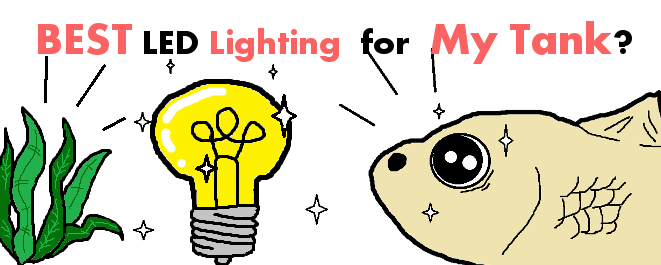
If you’re a beginner I first need to walk you through some basics and bust a couple of myths before I recommend anything.
The following guide will you on what to look for when choosing your aquarium lighting:
1. Your tank’s setup and livestock
The LEDs for plant and coral growth are way different. There are also the ones that accent the most on aesthetic performance.
When researching your LED lights of choice you should first ask yourself:
“What am I going to do with this tank?”
Typically, there are a couple of general setups:
- Some people prefer aquascape-clear tanks with plenty of beautiful fish in them. In this case, you’re after a light that brings out the most color of your fish;
- Some, like myself, prefer their aquascape as colorful as possible;
If you’re the latter, then:
Would you like to grow plants?
If yes, what kind of plants?
Different aquatic plant species require different light intensities.
How about reef tanks? There are too many corals, anemones, mushrooms, and whatnot to be listed here.
Corals can be soft and stony. Soft corals prefer lower light than stony corals.
This has a tremendous impact on your choice of LED aquarium lighting.
The best fixture for you might be the absolute worst for someone else.
Don’t worry though, further down in this article I have given my personal recommendation for most all tank sizes and setups.
It took my year-long experience along with quite some time to put this piece together. Make sure to read until the end, as it should give you the answer you’re looking for.
2. The dimensions of your tank
When choosing a LED or any light fixture for your fish tank it’s important to consider all of your tank’s dimensions:
- Length – The length determines the size of the LED fixtures you will be using. I know this seems too obvious, but if you’re into larger tanks you’ll understand me. Finding a suitable unit for smaller tanks is pretty easy as most will match the length of your tank. However, when you get to the bigger and more unconventional tanks you’d need to combine different fixtures to evenly light the whole aquarium. How many times have you seen a 72″ long LED aquarium light?
That’s right.
- Width – Not a super important metric to consider. The serving width scope of most LEDs that I will recommend in this article is 24 inches.Unless your tank is wider than that you have nothing to worry about.
- Height – Or should I say depth. This is even more important than nailing the right length.
Different tank setups will either have a clean bottom or substrate that amounts to a shallower tank. Newer models of LED lights do penetrate the water exceptionally well, but there will be some that are better than others.
And speaking of water penetration, let’s bust a myth once and for all…
3. PAR vs PUR vs PAS – in layman’s terms
You’ll likely hear these abbreviations a lot when discussing aquarium lighting.
PAR stands for Photosynthetic Active Radiation. This is the amount of ANY light in the spectrum between 400 and 700 nanometers.
This is the range of wavelengths that photosynthetic organisms can employ and it is considered the best light spectrum for growing aquarium plants and coral.
PUR, however, stands for Photosynthetic Usable Radiation. It’s what you’re after when you’re about to grow aquatic plants or corals.
Basically, PUR is the quality of light per application, where PAR is the quantity being sent.
This means that with everything else being equal (watts, lumens, source, length, and PAR) one lighting fixture could still grow plants better than the other if it has more PUR.
Simply put, PUR is the usable portion of PAR.
More PUR in your aquarium results in better plant health and growth. Fortunately, many of today’s manufacturers of LED lights are aware of that.
It’s why you see newer models of LEDs bringing in less PAR than their previous versions, yet they grow plants better.
This guy does a PAR review on the newer model and he seems baffled at why it’s producing less PAR than the Plant 2.0 LED. However, I can assure you that the 3.0 is a better performer when it comes to growing plants.
PAR meters only measure the number of photons between the 400 and 700 nanometers wavelength. They do not tell you if these photons are usable for your plant or coral.
So if a lighting fixture produced, say, 50 PAR at a depth of 21″ this used to be considered “good” performance. However, I noticed that it does not mean the light is the right kind of blue PUR for your corals (because corals typically thrive under blue light).
In fact, too much “unused” PAR will favor algae growth, and it can be a nuisance to permanently get rid of that.
Anyway, PAS – Photosynthetic Action Spectrum – is which photons activate precisely the Chlorophyll A and B, needed for plant or coral growth.
PAS and PUR vary for different organisms.
At greater depths, the water will “block” most of the red light. This is why corals have evolved in a way that the PUR they require leans more to the blue spectrum, which doesn’t get filtered out as much.
If you want to grow plants or corals that have totally different light requirements you should only be concerned with PAR (combined usefulness of light).
This way you’ll get the most of your lighting while compromising with the organisms’ individual requirements.
However, if you want to grow a specific group of species, say, only SPS corals, then you’d just need their specific PUR along with a set amount of PAR.
In this example, often that’s the LED lights that have the so-called Royal Blue diodes. The latter would likely produce the best results in terms of coral growth and health.
Following these thoughts, I think it’s now obvious that combining low, medium, and high light-intensity plants will result in one or the other not performing too well. Go after low to medium, or medium to high, or accent on either.
Author’s note: This is all in layman’s terms, and I’m no plant biologist by any means. I’m simply experienced in looking after aquariums.
However, I was obligated to do a little more research when I witnessed how a rather cheap LED aquarium fixture, that wouldn’t produce those elusive high PAR readings, was still able to grow plants better than a more expensive, “strong” model.
It’s the reason it has worked for me and also why I recommend all of those “budget” lights, even for growing corals.
Because they do the job.
Not to mention that whatever LED lights you end up purchasing you’d still need to tune it down to, perhaps, 25 to 35% intensity.
Now, don’t worry if this seems like too much to consider.
In this guide, I’ve taken care of that part for you. I’ve taken under consideration all of this in my recommendations below.
4. Quality of the build
One of the main reasons why LED lights became all the rage back in the day was their longevity.
Usually, most Light-Emitting Diodes have a life of 50 000 hours and that’s while working. All things equal this means that bombarding your plants viciously for 8 hours a day with light would still take a little over 17 years for the last of the diodes to die out.
But that’s diodes alone.
All LED fixtures have movable parts and far less durable side equipment such as their adapters, for example. These parts may need an occasional change now and then but nearly not as often as would the bulbs of an aquarium fluorescent lamp.
5. Included features and customization
When it comes to customization there’s too much going on in the world of aquarium LED lights.
There will be lights that are dimmable and others that are not. The most customizable ones will allow you to play with every single color that they offer.
When it comes to features there will be fixtures that could only be manually turned on and off.
Others will have built-in timers. Moreover, some can be programmed with a separately bought timer.
Also, remote controls may or may not be included in the package.
The fixtures with the most features will allow for weather simulations. The first time I saw this, I was very excited to try out the “passing clouds” and “thunderstorm” modes on some of my LED lights.
These are not super useful for your aquarium plants and corals but can be real eye candy.
6. Lenses, shadowing, and the “beam light” effect
Though it may sound counter-intuitive I was baffled to discover that diode lenses are a two-sided edge. Newer LED models for aquariums have lensing that is supposedly concentrating the beam more so that it can reach a greater tank depth more efficiently:
A lens that provides a 60º angle of the beam means that the light will be extremely concentrated and it will provide a greater water penetration.
However, this would also imply that there will be less color mixing of the beam, leaving you with the disco-like bottom.
Another outcome of a tighter lensing angle is the beam light effect.
I noticed that with these I wasn’t looking at an evenly-lit fish tank, but rather the stage of a jazz concert. I’d see where the beam of light ends and if the fixture was not long enough, I’d get shadows in the corners.
Author’s note: Luckily there’s nothing complicated in removing diode lenses when it’s needed (link to a video on YouTube showing how).
However, the good thing about most quality LED lights (as the ones I am reviewing below) is that they will penetrate the water hard anyway.
The Top LED Aquarium Lights: My Reviews and Thoughts
A decent LED lighting fixture will show the better colors of your aquarium fish and will be an efficient artificial light source for photosynthesis.
Here, I’m only reviewing models that have proven their performance to me or someone else I know.
If you want the best LED aquarium lighting fixtures try one of these:
1. Finnex StingRay – Really Good for Shallow Low-light Tanks
Advantages:- Slick, stylish design
- Rather bright, but it won’t overwhelm your plants
- Well-researched LED, that grows plants
- Plastic mounting brackets, which I didn’t really like because they are kind of brittle
- No programming, simply ON and OFF
The Finnex StingRay is not a super strong LED light that you’ll be able to grow a jungle under.
Still, there are smaller freshwater tanks that require such lighting.
You’ll be perfectly able to feed your non-demanding aquatic plants some sweet sun-like light, which will be more than enough for satisfying growth.
It has been my experience that this product would best fit a 5-gallon aquarium, which I discuss in detail in my recommendations below.
Since Finnex is an authority in the aquarium LED industry you’ll know that you get what you pay for.
The light is still high-quality in what it does.
Finnex manufactures durable products, which with LEDs is, in my opinion, quite important.
You’re going to run your equipment a couple of hours a day, after all.
Anyway, the Finnex StingRay does not have futuristic programming. You will only be able to turn it on and off.
Also, there’s no “night mode” which may be important for someone.
It will grow your plants, however, which may be MORE important to this someone, so bear that in mind.
The StingRay emits a 7000 K light that hits the 660 red spectra. As I mentioned above, this is in the photosynthetic usable radiation spectrum.
The guys from Finnex do their research when it comes to growing aquatic plants, so all of their LED lights have been proven to work for the purpose.
It comes with plastic mounting brackets, which is not something I am fond of.
I wouldn’t exactly call the brackets sturdy, but they do the job anyway.
Also for the people who are after looks – it’s a really stylish-looking fixture, something like a quarter of an inch thick.
Anyhow, the Finnex StingRay LED light is best for a shallow freshwater aquarium with non-demanding plants.
Author’s note: There’s this plastic cap protector that you should remove before turning it on. It’s really easier that way, just my personal experience.
2. Finnex FugeRay Planted Plus – High-tech Nano Tank Favorite
Advantages:- Very intense lighting
- Can grow high light plants like carpets and red plants in shallow to medium-depth tanks
- Has a lot of the true 660nm red diodes which help with growing difficult plants
- Beautiful design
- Has night mode
- Gives good colors to the tank
- Spectrum is not as fine tuned and may induce some algae growth if there aren’t enough plants in the tank
- Not dimmable
- A rather short cord
- Brittle brackets
And another product from Finnex, the FugeRay Planted Plus is one very bright LED light with deep water penetration.
I can’t say I’m particularly biased towards them, but my experience shows that they’re objectively good.
Anyway, if you plan on having a shallow tank, with a lot of plants that require high light, then this LED might be your best bet.
By “shallow” I mean a tank that’s under 12″ deep.
This light is really bright, with its 7500K spectrum and it has those red 660 nm wavelength LEDs, which play a role in plant growth.
In fact, at such tank depths, it will be strong enough to actually grow red plants. Speaking of which, for some ideas on red aquarium plants you can visit this post where I’ve listed a few.
Anyhow, when using this LED light, I’d recommend introducing CO2 to your system, as this light is powerful enough for some algae to appear. CO2 injections are not uncommon with high-tech tanks, which is why I recommend this light for this kind of setup.
Following these thoughts, I would also use the FugeRay Planted+ on larger planted tanks, as long as I have all of the bottom covered with plants.
If the aquarium does not house a lot of plants to consume the light and nutrients, this LED light will likely grow some algae.
Anyhow, the fixture is thin and will boost the overall look of your aquarium, which I like.
The FugeRay Planted Plus has a “night mode”, which is essentially a couple of blue diodes. The blue here will not help your plants grow, but it’s a nice showoff gimmick.
Author’s note: This LED fixture is not sealed, so having a lid over the fish tank would be a good way to prevent excessive moisture and rust.
Also, the body of the lighting fixture itself gets warm, but not hot, which is usually a plus in my book.
However, a con I would like to mention is that the cord is kind of short. This can be an inconvenience to some people, so consider it before making a purchase.
Other than that I can’t say a bad thing about Finnex’s FugeRay Planted Plus.
3. ABI Tuna Blue PAR38 – Budget-friendly LED That Actually Grows Nano-reefs
Advantages:- Awesome bang for your bucks
- Will definitely grow SPS corals
- Brings out nice colors in fish and corals
- Durable, thanks to the PAR38 design
- Tighter cone of lighting coverage, but still great for certain setups
- It’s heavy, needs a sturdy lamp neck
- Very little white light, so you might want to buy a separate one for show-off purposes
The ABI Tuna Blue is inexpensive by the reef-keeping standards.
It comes in 12W and 24W bulbs.
These LEDs are the best bang for your buck when it comes to keeping a nano-reef.
It suits small tanks and it can absolutely grow SPS corals.
The lower watt version is to be used in soft coral nano-reefs, but again, that correlates with the depth of your aquarium. If your tank is between 8 and 12 inches deep then you’ll have no issues growing SPS species.
The tricky part is that most of the time when you have a wider tank you’d have to buy 2 or 3 depending on the length of your aquarium.
I give additional guidance on that in my setup recommendation section below.
The PAR38 in the ABI Tuna Blue bulb has nothing to do with its Photosynthetic Active Radiation output. In this case, PAR stands for Parabolic Aluminized Reflect, which in laymen’s terms means that the lensing is internal, resulting in a more durable and brighter light.
Anyway, the LEDs of the ABI Tuna Blue will appear as if they have stickers on them. These are diffusers and are not to be removed!
The bulb matches the natural light spectrum of where most of the corals in the hobby are seen in the wild.
It is, I think, the best PAR38 bulb out there, doing a fantastic job as LED lighting for smaller tanks. I guess the ABI manufacturers have done their research on PUR. I have seen this product grow all kinds of Acropora fragments, for example.
Anyhow, a con I would like to mention is that the ABI LED light is designed for pico reefs. This means that it does not cover a lot of ground.
However, as with most LEDs suggested for reefing it’s way stronger than what it’s “built for”. To be able to cover your 5 or 10-gallon reef with lighting you’d usually need to purchase two bulbs.
Still, if you’re on a budget it’s going to be way cheaper than getting the more expensive lights while providing your tank with the same if not better results in terms of coral growth.
4. KOVAL – Fantastic for Basic Tanks with Very Few or No Plants
Advantages:- No needless features which cuts down the price
- Surprisingly durable for the money
- Helps to bring out the colors in fish
- Power supply can get hot
- Basic (but ideal for simple setups)
I should start my review by saying that this fixture should only be used in freshwater fish tank setups. I’ve seen it being recommended for saltwater aquariums and corals and it is simply not the case with this model.
Anyhow, at first I was hesitant to include the KOVAL LED lighting in my list because of two main reasons:
- it used to be that the light would break too easily;
- the model seemed too basic.
However, eventually, I realized that the guys from KOVAL have improved on their LED fixture tremendously since they first released it.
Firstly, the reports about the KOVAL breaking easily or too early suddenly stopped sometime around 2018.
It turns out that back then the manufacturers had made some changes to the design and build quality of their LED light.
Since then I rarely hear someone complaining about the KOVAL aquarium lights, if at all.
In fact, all owners seem extremely happy with their purchase and it seems like this fixture got overwhelmingly popular.
So let me quickly define “happy owners” in the context here.
This light is pretty basic (same as the NICREW one) and has nothing to offer but some bright, uncontrollable light to make the colors in your aquarium pop.
If I had a simple tank with some very colorful fish species, I would get the KOVAL to help their colors stand out.
I would not, however, count on this LED light to grow my plants. It may be bright and supposedly full-spectrum, but I haven’t seen decent growth results by it, even with low-light plants like Java Fern.
Anyway, all of this is okay since most beginners start their aquarium with some fake plants and the KOVAL LED light is perfect for such setups.
5. AI Prime 16HD – High-end LED for Shallow-Depth Reef Tanks
Advantages:- Highly customizable
- Lightweight, small-sized fixture
- Very affordable for a high-end reef LED
- No beam light effect
- Long-lasting
- Virtually silent fans
- You may need more than one for your setup (read my recommendations guide below)
- Setting up the App for the first time can be confusing
- Doesn’t provide the typical ocean-like shimmering that more expensive LEDs give
The AI Prime 16HD is, as the title goes, a high-end reef LED that’s suitable for shallow to medium depth tanks.
It’s not really expensive by the reef-keeping standards, it even leans to the “affordable” side.
However, it does not provide plenty of ground coverage. So for a lengthy tank, you’d really have to open your wallet up. This makes it a common choice for smaller cube tanks with a length and width of 12 inches.
The initial pricing is based on two valuable qualities important in the reefing world.
The first quality is its potential to grow pretty much anything in its suggested depth range (between 12 and 16″).
Read: stocking your tank with only demanding stony corals won’t be a problem for the AI Prime 16HD.
The second one is that this reef tank LED is highly customizable.
The AI Prime 16HD Reef comes with an app that lets you tinker with eight light channels. Once you get used to it, it will be a breeze to play with the different settings.
Anyway, in my opinion, this LED light is not heavy, so positioning is naturally not an issue.
Another thing I like about it is that apart from its sleek design, it runs quietly. Sometimes I was barely able to hear the fan spinning.
Many reefers would be more than happy to recommend you this light.
The reason I am recommending it, however, is because I think its price is justified and it’s not some overkill $700 reef light.
For an actual specific recommendation make sure to check my guide on sizes and setups below, where I speak from personal experience.
Anyhow, because of its advanced customization, the AI Prime 16HD Reef is probably the best product for a shallow to a medium-depth aquarium that houses corals which demand more intense lighting.
6. VIPARSPECTRA Timer Control Series – Tons of Features & Power
Advantages:- Strong and efficient LEDs, grow demanding corals
- Dimmable
- Timer
- Affordable
- Wireless remote
- Every 2-3 months the built-in timer tends to lag behind with a couple of minutes; nothing really major
- Doesn’t have a ramp-up and ramp-down feature; Me and my corals loved it anyway
The VIPARSPECTRA Dimmable LED is no doubt my personal #1 aquarium lighting recommendation if you’re on a budget.
Let me start with the pros of this fixture.
It’s strong – like, it has no problems lighting up the bottom of a 30-inch deep reef tank. You’ll be able to grow whatever is under it, as long as it falls in its coverage.
On to the next one – its super competitive price.
For what this fixture allows, I can safely classify it as undervalued by its manufacturers. Let’s just hope they’re not reading my review.
Anyhow, let’s talk about the features. The VIPARSPECTRA has the oh-so-valued Royal Blue diode (450 nm) for your corals and also all the necessary wavelengths for a healthy planted tank.
Both the blue and the white light channels are separately adjustable in intensity, or “dimmable”.
Anyway, the VIPARSPECTRA comes with a built-in timer as well, which I find a very convenient feature. I also like that it has a long cord, and a wireless remote, which already makes it unbelievable for this price tag.
So far so good right?
Well, there are some minor cons which, I think, is only fair to point out.
See, the VIPARSPECTRA LED fixture only comes in 2 lengths – 31.5″ and 16″.
I’m only mentioning this in relation to the small issue with the built-in timer.
So for larger tanks that are not over 26 inches deep, you’d want to set up multiple fixtures of the smaller ones as they are 165W. A clever setup would be to have 1x VIPARSPECTRA per 24 inches of aquarium length.
Such tanks are pretty much all the tanks from the 25-gallons to the 125-gallons (standard size). They are not deep enough for the bigger version, be it reef or not.
The larger, 31.5 inches long, fixture has tremendous power and would pretty much fry everything beneath it unless your tank is 26+” deep.
And here’s where the timers come into play.
They do tend to go out of sync with time. This happened to me and to most of the fishkeepers, according to their reports.
Fortunately, the gap is something like 10 or so minutes between the fixtures every couple of months.
So It would not go off by a mile, but it may be an inconvenience for some people.
If you’re okay with doing some surveillance every 3 months then nothing should stop you from getting the VIPARSPECTRA lights for your reef tank.
7. Beamswork Vivio Full Spectrum LED – For Colorful Fish and Planted Tanks
Advantages:- Budget-friendly
- Beautiful daylight spectrum that makes colors pop
- Nicely designed
- No additional features
- A timer is not included (Beamswork offers one separately that’s pretty reliable, while super inexpensive)
- The colors may not blend well if the water surface moves a lot (if your tank’s bottom is not plain white sand and empty space, then you’ll not really see this effect.)
If you read my fish tank setup recommendations below you’ll find that I mention the regular Beamswork FA FSPEC a LOT.
Well, it’s just that in my opinion, it’s the best fit in numerous cases where your aquarium needs LED lighting that supports low-light plants.
If your lightly planted tank falls on the shallow end – under 16 inches of height – then the regular Beamswork is your friend.
I am most happy with it, because it’s a really budget-friendly set of LEDs, and I’ve seen plants respond in just days after the installation.
The longer fixtures are absolutely fantastic for big, fish-only display aquariums, with a java fern here or there. You should totally try the regular Beamswork out if you have a nice lengthy tank full of cichlids.
Anyway, this review is about the very successful Beamswork Vivio Full Spectrum LED.
This LED light is a slightly modified version of the regular Beamswork and is oriented towards plant growth.
It’s literally a few dollars more, but there’s a noteworthy difference in the response of plants between the two.
Author’s note: A single Beamswork Vivio LED is very intense and is good for high-tech tanks with low or medium depth.
However, lining two Pent fixtures next to each other would allow you to grow actual carpeting plants in a deep, planted tank (24 inches of depth).
Anyway, there are disadvantages here too, so let’s go through them. Or rather a con.
For a light of this price bracket, it’s probably normal, but here it is – it lacks additional features.
You only get two lighting modes with this light. There is absolutely no customization to this product.
Not really a big deal to me, as for the money I can’t force myself to want more from the Beamswork Vivio LED.
Also if you’d like a timer, you should get it separately.
I recommend getting the timer.
It allows switching on and off differently colored LEDs. It’s really reliable for just about $15 bucks extra.
Apart from all that, the Beamswork LED lights have a beautiful design, which I’m quite fond of.
It’s sleek and simplistic, so it kind of boosts the overall look of my aquarium.
8. NICREW ClassicLED – Top Seller for a Reason
Advantages:- Affordable
- Has night mode
- PAR per dollar will maintain low-light plants
- Beautiful daylight spectrum, makes fish colors pop
- Works for multiple standard-sized tanks
- Not very durable overall
- Not waterproof (just install it over a glass top and it’s a problem solved)
- The extendable bracket does not mean more light coverage
- Brackets are kind of loose
The simplistic LED light from NICREW Classic is one of the all-time top sellers on Amazon.
It has a ton of positive reviews from the buyers.
…And I can’t blame them.
The NICREW ClassicLED is the ultimate multi-setup budget light for the majority of freshwater aquariums.
It will take care of low-light plants in any medium-depth tank (16 to 21 inches deep ones).
It’s incredibly efficient in terms of PAR for the price. Roughly 1 PAR per 1 dollar, which is pretty much outstanding.
However, PAR is not everything, but it seemingly provides the needed PUR as well.
Low-demand plants will absolutely be okay under it.
The manufacturers have done their homework and are currently killing the competition with their inexpensive solution.
Another setup this light is great for is a FO display tank (Fish Only).
The nicely distributed white light certainly highlights the colors of a fish.
The NICREW ClassicLED also eliminates the fat electricity bills.
Generally speaking, LED lighting is overall economical in that aspect, but this fixture is among the most energy-efficient among the energy-efficient ones.
With all of the positives discussed, onto the cons we go!
Every product will have its cons, even the really good ones.
What I can mention here is that this light is not waterproof.
It’s not a sealed type of fixture so having it above a glass top is a must. An open top can significantly shorten its life.
Another thing I feel is noteworthy is the extendable brackets.
The manufacturer’s suggestions for suitable tank lengths are kind of misleading. Yes, the brackets will extend and the light will fit the tank. This, however, does not mean that you’ll end up with an evenly lit tank across the whole length.
If you get the 12-18″ fixture for an 18″-long tank you can expect shadowing in the corners.
In my personal recommendations on lighting different tank setups below, you’ll find where the fixtures fit in the most efficient way.
Just find your desired tank size and setup and read the tailored recommendation.
Another thing I can say about the brackets is that they are not exactly locked in place.
They go in as easily as they go out. An unintentional push can send your light inside the aquarium.
However, if you listen to my advice and install the NICREW above a glass top you will avoid any accidents.
It’s an overall killer aquarium light for the money. Thumbs up from me.
9. Current USA Orbit Marine – Weather Patterns in Shallow Reef Tanks
Advantages:- Has most extra features in this list
- A ton of value for the money
- Will grow your corals if you follow my setup recommendation guide
- It fits a very narrow range of tank depths
- Gets rusty with time (just install it over a glass top and you’ll be fine)
My personal observations for the Current USA Orbit Marine conclude that it can certainly fit medium-shallow reef tanks.
It can be successfully employed to grow less demanding coral in the 16 to 21 ” tank height range.
Its power doesn’t really go beyond that, however.
For more info on where this LED best fits, I suggest that you read my recommendations guide below.
For a quick summary, I can say that in certain shallower setups with 12″ to 16″ of depth you will be able to grow SPS corals.
Anyway, another thing that this light stands out with are the multiple weather modes.
You can choose from passing clouds, lightning storms, bright clean sky, and whatnot.
It’s definitely made for show-off tanks.
And let’s face it, it’s nice when someone comes over to your house and is like “Wow, your tank looks super realistic”.
It comes with a remote, a timer, and a dimmer as well.
It’s not super budget-friendly but for a reef light with this many features, it’s an astonishing deal for the money.
A small inconvenience I would like to mention is that these lights do get rust after prolonged exposure to humidity.
If you choose to have it with only the mount brackets, I say have a glass top at least.
You can also get the gooseneck to mount it higher where the evaporations won’t reach as easily. So there’s that.
It’s an overall great LED light, and many reefers are happy to use it.
10. Finnex Planted+ 24/7 – The Best Planted Tank LEDs
Advantages:- Will grow any plant in medium to deep tanks
- The 24/7 mode is actually useful and not a gimmick
- Tons of modes and features, as customizable as it gets
- Phenomenal price for the provided value
- The typical for a Finnex shorter cord (oh, well)
The Finnex Planted+ 24/7 is hands down the best LED light for plants that require medium to high lighting for good growth.
This LED fixture can take care of your high-tech planted tank with ease, as long as it falls in the medium-depth range (12 to 21″ deep).
The shallower the tank – the more CO2 you’d need to suppress a potential algae bloom.
Anyway, the Planted Plus 24/7 is an absolute masterpiece in the world of well-researched LEDs.
Finnex made sure that your plants will get every last bit of PUR light from their product.
With this LED fixture, I’ve grown even the most pretentious and demanding carpet plants.
Not only that – even red aquatic plants will thrive under it.
At this point, you may be aware that red plants are generally harder to grow because they require a lot of the right kind of PUR.
Anyhow, let’s talk about features.
The Planted Plus 24/7 lighting fixture is smart. With the wireless remote you can simulate all kinds of weather patterns upon the push of a button.
You can also take advantage of the 24/7 mode (duh).
The 24/7 mode is basically a 24 hours a day simulation of a rising sun, noon, afternoon, sunset, and moonlight throughout the night. The mode is amazing for the plants but if you’re not doing CO2 you may end up with algae because of the night blue light.
I do recommend this LED light only if you’re after a medium or high-tech planted tank, which includes CO2 injections by definition.
If you’re not a fan of fancy lighting modes you can still use the Finnex Planted Plus 24/7 as a regular LED light on a timer.
You can also fine-tune the spectrum manually and set it at your desired combination for a certain time a day.
Anyway, this LED fixture comes with the same weird brackets as the Finnex Stingray, which you can mount on either rimless or a fish tank with a brace.
The only actual con I can point out is that the cord is a bit short. Finnex keeps doing it for some reason.
This light is used by beginners and experienced fishkeepers alike. That’s top quality right there.
Author’s note: The Planted+ 24/7 comes in a lot of different sub-varieties named with what seems to be confusing code letters:
- KLC
- HLC
- CRV
- ALC
- CC
- SE
I’ve found that, if you are a perfectionist and want to get the absolute most for your plants’ growth, you should likely get either the ALC or the CRV. The CRV worked the best for my tanks that were up to 21 inches of depth. The ALC, on the other hand, has roughly 50% more power than the CRV and is useful for very difficult carpeting plants and deeper tanks.
11. Current USA Satellite Plus PRO – Good for Heavily-Planted Forest-like Tanks
Click to compare pricing + see MORE photos of this product at:
Advantages:- Strong enough to grow medium-intensity plants
- Won’t promote algae
- Features, features, features
- Good for colorful fish
- Timer remembers the settings even after a power outage
- May seem a bit overpriced compared to the other top performers
- Remote control needs a shorter distance to work
- Not exactly waterproof (use over a glass top)
This aquarium LED best suits a heavily planted tank with medium-light requirements.
It is not powerful enough for a “high-tech”, but it will do a fantastic job for the aforementioned setup.
What I also like about the Current USA Satellite+ PRO lights and their output is that they won’t stimulate algae blooms.
You can read my setup guide below to see which tanks I recommend this LED fixture for.
I am usually putting it to work in tanks with a great variety of species that also don’t have an empty spot on the substrate.
Anyway, this lighting fixture has the usual chest of features that the Current USA fixtures are famous for.
It’s a programmable LED aquarium light that includes all kinds of weather patterns, even the super stressful-for-your-fish “thunder” mode.
All good show-off features for a display freshwater tank.
Anyhow, the Satellite Plus PRO comes with what I can call a smart timer. The timer will remain properly set even after a power outage, unlike others that will reset themselves.
Eliminating that common nuisance is a really valuable feature, I must say.
A con to the timer, however, is that after the outage you’d have to manually turn your aquarium lights on.
Not really well-thought as this might happen when I’m out of town, leaving my plants in the dark for the time being.
Anyway, the remote that the Current USA Satellite+ PRO comes with is low on range so it kind of defeats the purpose of having a remote.
Author’s note: These lights are susceptible to damage from water evaporation, so a wise move would be to run them over a glass top.
Advantages:
- Fantastic spectrum that works for plant growth
- Pre-set modes that will grow aquatic plants
- Very customizable
- Sturdy build
- Beautiful design
- IP67 waterproof rating, meaning water vapor, dust and even an accidental drop in water won’t damage it
- 3-year warranty
- Works great for medium and deep tanks
- The app is not something Fluval should be proud of. It needs more work as it’s not a smooth user experience right now
- Somewhat pricey for a freshwater aquarium LED light
There was a time I thought the Finnex Planted Plus 24/7 was undisputed in being the best LED aquarium light out there.
However, with more experimenting with other “premium” LED lighting I changed my mind.
Currently, my opinion is that the Fluval Plant 3.0 has successfully dethroned Finnex’s Planted+ 24/7 and is officially the best LED light for planted tanks.
Although the Planted+ 24/7 ALC has more raw power in terms of PAR, the strength of the Fluval Plant 3.0 lies in its superior spectrum.
It is just amazing to me how an LED light with such unimpressive PAR as the Plant 3.0 is able to make aquatic plants flourish in medium to deep aquariums.
Apparently, this LED grow light gives off the exact light wavelengths that plants need to thrive.
As for customization the Plant 3.0 is not difficult to set up once you get the hang of its app.
You can use the pre-set modes, from which I personally recommend the “Planted Tank” one.
This mode grows aquatic plants like weeds and you don’t need to tinker anything further.
Ideally, it’s the most hands-off approach which I’d always recommend for a beginner with a planted aquarium.
Speaking of settings, I am not hesitant to admit the app of Fluval Plant 3.0 is kind of bad.
And that’s after Fluval had a considerable amount of time to fix the nuisances that plagued this so-called app.
Don’t expect it to be unusable, just know that during configuring light colors and so on it may not be smooth sailing.
Aside from the weird software, the hardware of the LED strip itself is rock solid.
The build is sturdy, the design is slick, and the light diodes seem cherry-picked and of high quality.
No complaints here.
Moreover, the Fluval Plant 3.0 actually has an IP67 waterproof rating.
This rating basically means this LED light is totally protected against dust and can be submerged in 1-meter-deep water for about 30 minutes without damage.
This kind of waterproofing is very rare amongst aquarium lighting products in general and makes the Fluval Plant 3.0 extremely durable and puts it on the slightly pricier side.
Nevertheless, it is one of, if not, the best LED aquarium light for medium and deep planted tanks out there.
If you’re serious about your new planted tank and want to pursue the more demanding aquatic plants then the Fluval Plant 3.0 is for you.
13. Hygger 24/7 – Customization on a Budget
Advantages:- Budget-friendly
- Pre-set 24/7 mode grows low-light plants
- Cutomization
- Seemingly protected against water evaporation (no official waterproof rating though)
- Looks great
- “Dud” batches that may sometimes leave you with a product that stops working around the 1-year mark
- Because of how the pre-set modes are programmed you do not get the maximum potential growth out of your plants in the long run
So, basically, if the KOVAL LED light from entry #4 is the most basic upgrade to a fish tank’s lighting then the Hygger 24/7 is next level after that (remember that the entries here are not ranked by “quality”).
The Hygger 24/7 is practically the KOVAL but with some decent customization options on hand.
With the Hygger you get some lighting periods and a basic timer. Programmatic lighting cycles are not something you can find elsewhere at this price bracket.
The programming, on the other hand, is not ideal. The light starts dimming too early for my taste and this can affect the performance of the light over time. Simply put, although you get a pre-set mode with the Hygger 24/7, it won’t be able to squeeze the maximum growth out of your aquatic plants.
As for how well this LED light grows plants – it will handle low-light plants. You can’t expect to grow red or carpeting plants with the Hygger 24/7, but that’s to be expected at this quality bracket.
If you’re new to planted tanks and don’t plan to look after anything other than some Java Fern, Anubias, or Anacharis – get it this light and call it a day.
Now let me discuss durability.
This is not the most durable light out there.
From what I gather from reports of other fish keepers, there’s a chance you’d get a dud.
This basically means a fixture that will break at or around the 1-year mark. This is not ideal, and no one wants to renew their aquarium lighting each year.
My personal Hygger 24/7 did not break in the first year mark, and I haven’t put any special effort into caring for it.
I’ve been treating it as a normal LED light as far as maintenance goes. To me this really suggests there are dud batches out there, so keep that in mind when ordering.
As a verdict – If you’re into the hands-off approach and will not try to look after demanding aquatic plants then get the Hygger 24/7.
What LED light should you use according to a tank’s size and livestock setup?
Setups, sizes, and fish tank dimensions vary greatly but so does my experience. For this reason, I wanted to actually craft a helpful guide with my recommendation for each of the above.
That’s right, listed below you’ll find a very situational gear suggestion for each fish tank size and livestock option.
Here are my detailed pointers on LED lights that I found to best fit certain gallon capacities and tank setups:
The top LED lights for a 5-planted tank
For a 5 gallon planted tank that has low-light demanding plants I can recommend the Finnex Stingray LED:
It’s bright enough but it won’t overpower your greens. They have a 16″ inch version that perfectly fits a standard 5-gallon tank. You’ll be able to grow a beautiful underwater mini green field with it, as long as you choose the right plants.
If you want to grow beautiful carpet plants that require high lighting such as Dwarf Baby Tears and whatnot you should look up The Finnex Fugeray Planted+ 16-inch fixture.
Amazon has them.
It’s not a really cheap light per se, but if you’re into high-tech nano tanks, you’re probably prepared for that.
You can absolutely get the best results with that LED, as long as you tune down the time it’s on.
Mind that CO2 will be needed if you want to avoid an algae bloom because the Finnex Fugeray Planted+ is a really strong LED light.
However, you definitely won’t be limiting your tank when it comes to demanding plants.
The top LED lights for a 5-reef tank
For lighting up a 5-gallon reef tank that houses a mixed variety of LPS, SPS and soft corals I am recommending the ABI Tuna Blue 12W.
This is the best performer in terms of price and productivity, in my opinion.
At a depth of 10 inches and a length of 16 two bulbs will do you well. You’ll be able to grow any zoas, mushrooms, and soft corals.
So long as your water parameters are stable and you keep up with the water changes and nutrients your SPS will grow just fine with this LED.
I see reefers that go with the Current USA Marine Orbit for this setup too often. In my opinion, that’s kind of overkill as you’d have to keep it at a minimum intensity to not slow your corals’ growth or bleach them completely.
The top LED lights for a 10-planted tank
Honestly, if you’re not planning on growing a full-blown forest in your 10-gallon tank then any mid-range Chinese LED light would do wonders.
As long as you keep up with the CO2 and have adequate nutrients in the water you will be perfectly fine:
For a depth of 12 inches and a length of 20, the Beamswork FSPEC could come in pretty handy. It performs pretty decently on lumens and PUR in 10-gallon tanks and it will be more than enough to sustain your aquatic plants.
If you want to grow some high-light requiring plant you may look up the Finnex Planted+ FugeRay LEDs.
These are considered medium-to-high lighting fixtures.
My experience with a 30 gallon heavily planted tank (also 12 inches deep) shows that they lean more to the “high” part.
I was able to grow high-light requiring carpet of Dwarf Hairgrass very successfully.
I am confident that with the Finnex FugeRay Planted+ fixture and this depth you won’t limit your planted tank’s options.
I would also advise against getting the FugeRay Planted+ unless you really want to try to cover the aquarium’s substrate with a very demanding grass-type of a plant.
Author’s note: If you’d like to start with non-demanding plants and gradually introduce harder ones with time you could get the Beamswork DA Pent. Just make sure to also get the separate Beamswork dimmer/timer and set the intensity to about 50% and the time period at 6 hours in the beginning.
The top LED lights for a 10-reef tank
For a 10-gallon reef tank that revolves around newbie-friendly soft corals, zoanthids, and, mushrooms I would recommend getting an ABI Tuna Blue 12W.
Or two.
If yours is a typical 20″ x 10″ x 12″ aquarium two bulbs would sufficiently cover all ground. If you’re still loading the tank up with corals, one bulb may be enough, depending on where you will position it.
However, if you’re evenly covering the bottom with corals, throughout the whole length you’d need 2 fixtures.
For the depth of 12 inches, the 23W bulbs will perform better than the 12W when looking after SPS.
The 12W suits smaller nano-reefs. From what I’ve seen with 2 bulbs you can successfully grow LPS corals in non-typical fish tanks of 13 and 15 gallons as well.
For an SPS dominant 10-gallon fish tank, you can safely get 2x ABI Tuna Blue 23W.
They’re overall great LED lights, and for a depth of 12 inches, you can grow just about anything with them.
…Even advanced-level SPS corals.
However, be careful not to bleach your corals.
Mount the bulbs high at first and monitor how your corals react.
Gradually adjust the height of the bulb over the course of weeks, if needed.
The top LED lights for a 20-planted tank
20-gallon tanks come in various shapes and sizes, with the two most popular being a 20-gallon long and a 20-gallon high. I will discuss both here:
For a high one, measuring 16″ height and 24″ in length that is “low tech” you should probably get a Beamswork EA FSPEC or NICREW ClassicLED (link leads to Amazon).
Both come at pretty much the same price.
Both will do great in an aquarium that has low-light plants.
Author’s note: The NICREW may come a little shorter for a 24″, but if you don’t have plenty of plants in the corners you will be fine. If you decide on the NICREW, use it over a glass or other transparent material.
Anyway, for a high 20-gallon aquarium that’s heavily planted, with needy plants, you’ll want the controllability of a slightly more advanced lighting fixture.
The Finnex Planted+ 24/7 will allow you to stock your 20-gal aquarium with whatever high-light plants you want.
Don’t take my word for it if you want, but this is the best LED light for planted tanks on the market right now. The 24″ fixture will fit the top perfectly, bathing your livestock with intense photosynthesis-usable light.
Honestly, any Finnex fixture that’s advertised for plant growth will do pretty well here. Don’t forget to keep up with the CO2 though. Algae soups are not nice.
Moving on, for a 20-gallon long tank with easy-care plants you can still go with the NICREW, but this time the 28″ – 36″ fixture:
The efficient light spread will be at 28″ of length, which would be enough for such a setup. As the long version of the 20-gallon is still 12″ of depth you shouldn’t go past my recommendations for the classic 10-gallon tank above. However, this time the Beamswork EA FSPEC should be the shorter one where the NICREW has a perfect 30″ long fixture.
My success has been with growing some low-light carpet plants such as Staurogyne Repens and Marsilea Hirsuta with the NICREW. I’m assuming this is due to how shallow a tank of such size is. However, my tanks in that case had CO2 and fertilization, so keep that in mind.
Anyhow, for a 20-gallon long “high-tech” fish tank, I wouldn’t go beyond a Beamswork DA Pent with a dimmer, to be honest.
Growing strictly super high-lighting plants and carpets can be easy with the Beamswork 0.50W Pent LED.
That’s a stronger version of their regular DA FSPEC, specially designed for growing plants.
Fortunately, it’s not pricier by any means. The 30″ Beamswork Pent LED fixture will grow just about anything in a 20-gallon long aquarium.
The top LED lights for a 20-reef tank
My 10-gallon section recommendation from above stands, as the standard 20-gallon long has the same depth of 12 inches.
Only this time instead of 2 ABI Tuna Blue bulbs you should maybe go for 3. You want to cover all of the 30″ of length of the tank.
The light from these LED bulbs will penetrate the water very well, and at 12 inches of depth, your SPS corals could grow all over the place.
Anyway, for a mixed reef with SPS positioned closer to the surface, the ABI Tuna Blue 23W combo will do just fine.
There’s also the 20-gallon high aquarium, where we’re looking at a depth of 16″.
For an aquarium of these dimensions that’s dominated by softies, you’ll have no issue running a Current USA Orbit Marine. In fact, you could run that with an SPS-dominant top level of the tank as well.
The depth of 16 inches is not a challenge for that fixture.
This is according to my experience.
Some users advocate that an AI Prime 16HD Reef will perform best if you want to keep SPS corals in this setup.
The Prime comes at a slightly higher price. It’s a high-end light and it will be more than sufficient for a 20-gallon high tank, true. It has customization and it runs quietly while providing top performance.
Obviously, if your budget is looser then you should get the AI Prime as it’s more durable in the long run and you’ll benefit from the crazy customization.
However, in terms of efficiently looking after SPS corals, the Current USA Orbit Marine has done well by me and that’s even at greater depths than 16″.
Your call, really. I say let your budget decide here.
The top LED lights for a 30-planted tank
As most 30 gallons are breeder tanks, I’m assuming you’re looking for a LED light that would support high-growing easy-to-care-for plants:
Most people go for something like Vallisneria because it grows well and helps the baby fish make it. A typical 30-gallon tank has dimensions of 36″ length x 12″ width and x 16″ height. If you’re looking to grow dense, but low-light requiring plants I can only point you in one direction – BeamsWork EA Timer FSPEC LED Aquarium.
It will be more than sufficient and they offer a nicely fitting fixture of the same length.
You’re set.
If you plan to go with a fully planted 30-gallon forest-like fish tank, then my suggestion from the 20-gallon section remains. For supplying 14 inches (minus substrate) with a high light I stick to my recommendation of the Finnex Planted+ 24/7.
This model comes in a 36″ length, which will fit your needs perfectly.
The top LED lights for a 30-reef tank
As I discussed, for a depth of 16″ which is what a standard 30-gallon tank has the Current USA Orbit Marine will do you wonders.
I suggest that you get the 36″ to 48″ fixture, and not the smaller version, as this one’s physical length is almost 35 inches. In fact, you can use the Current USA Orbit Marine LED for growing SPS corals as well.
The top LED lights for a 40-planted tank
For lighting up a planted 40-gallon tank with a few plants I would suggest a NICREW ClassicLED light or a BeamsWork EA Timer FSPEC:
The two types of 40-gallon aquariums are the long one (48 inches in length) or the Breeder (36 inches in length).
However, they’re both 16″ deep so the tank size doesn’t come into play that much but rather your desired setup.
The only thing to consider for your choice between the two is the length of the aquarium.
For the 36″ breeder go with the BeamsWork and for the 48″ 40-gallon long – choose the NICREW.
That’s only because each of them has a suitably sized fixture for the respective tank.
If you want to grow java fern, easy mosses, and Anubias you can be sure that one of the above models will do the job.
When I grew these plants, my only concern would be that they’d grow high enough to cast shadows on one another. As they are hardy and grow relatively fast, please remember to trim them when needed.
Anyway, I have a neat solution in mind for a medium to high-tech 40-gallon planted, as well:
The Finnex Planted+ 24/7 will give you plenty of programs to play with, but you can manually customize it if you wish. Don’t go over 8 hours a day if you want to go the manual road.
It comes in both 36 and 48 inches so you’re pretty much set here.
Growing an underwater jungle is not uncommon with this aquarium light.
Virtually, you can choose aquatic plants of any difficulty here.
Keep in mind that it’s a strong LED light, so a CO2 injection may be needed to control algae.
The top LED lights for a 40-reef tank
Here’s what type of LED lighting a 40-gallon reef aquarium would benefit from:
The Current USA Orbit Marine LEDs would perfectly fit your 40G reef.
For 16 inches of depth that will probably have 2 inches of substrate, this LED light will do the job. And by doing the job, I mean you could grow whatever – from anemones, softies, and LPS to SPS corals.
Anyhow, I am recommending the Orbit Marine for two reasons.
The first one is because the model has suitable fixtures to fit the length of your 40-gallon reef.
It doesn’t matter if you have the Breeder or the long version here (if you’re going after standardly sized tanks).
The second one is because it is dimmable.
This means that if you start with newbie-friendly corals and want to gradually add up more needy corals you could just increase the intensity.
Honestly, I don’t know a reefer that has ever kept it to LPS only. I included.
Anyway, the Current USA Orbit Marine LED light is strong as well. Believe it or not, your corals will perform best when you have the LED running at about half of its potential or less.
I suggest that you start off low and gradually increase the settings, with the blue light prevailing.
Monitor how your corals react, as with every aquascape it is different.
The top LED lights for a 55-planted tank
What I’m about to recommend may seem a counterintuitive LED light choice for a planted 55-gallon tank but bear with me.
If you’re only planning to grow aquatic plants that require low light you can absolutely go with the NICREW ClassicLED Plus Planted.
Though a 55-gallon is 21 inches in depth the NICREW will be enough to maintain these plants.
Just to make sure you don’t get me wrong – I’m talking Java moss, java fern, Anubias, crypts, and, perhaps, wisteria.
I’m using this light on my 125-gallon aquarium which is the same depth as a 55 one.
My non-demanding plants are growing moderately well, feeling happy and all. The NICREW LED light is pretty bright, penetrating the depths of the aquarium well (or at least my plants think so).
Anyhow, the lower price of this LED fixture comes from its lack of customizable features.
You won’t be able to dim it (unless you get the separate dimmer) and it doesn’t have fancy weather modes.
Still, it does a fantastic job for this kind of setup, bringing out the nice colors of my fish, included.
Just to clarify, typically a 55-gallon is 48″ x 13″ x 21″ ( L x W x H ) and the NICREW LED has a suitable fixture of 46″ (without the extendable brackets). This LED is what I would call “the best bang for your buck”.
Anyway, to equip a heavily planted 55-gallon tank with appropriate LED lighting I can vouch for the Current USA Satellite Plus PRO.
Being strong enough for my plants aside, the Current USA Satellite is customizable, unlike the NICREW LEDs. It is also considerably more durable in my observation.
Author’s note: Keep in mind that heavily planted, doesn’t mean growing pretentious plants. It just means having the bottom of the tank covered with plants.
I run this LED fixture on a 21″ deep tank that does not require much maintenance, while still being heavily occupied by my greens.
The reason I did not use the NICREW here is that I have way more species of plants, and the Current USA Satellite Plus PRO gives me some flexibility.
It can also be programmed with a separate timer, which in combo with its multiple effects makes for a perfect planted tank to show off with.
For my timer, I just went ahead and purchased the first one with a decent amount of positive reviews on Amazon. I must say that I’m pretty happy with my choice. My plants are growing strong and display lush green colors, so I guess you could say everyone is happy.
But what if you want an LED light for a 55-gallon “high-tech” aquarium?
If I’m ready to employ high-tech substrates, dosed nutrients, and high-light requiring plants there’s no doubt that I wouldn’t want to compromise with my LED lighting.
I haven’t run a “high-tech” tank that’s 21 inches deep myself.
However, I’ve worked with clients, setting up their tanks, which are thriving to this day.
Anyway, according to my experience, and the knowledge which I shamelessly “stole” from one of my best buddies that actually runs more than one of these tanks, I am confident to offer you a solid recommendation.
Actually two:
The best LED lights for a 55-gallon “high tech” aquarium are the Fluval Plant Spectrum 3.0 and the Finnex Planted+ 24/7 (surprise, surprise).
So, I run the Finnex on other planted tanks and as I already mentioned, to me, this is one of the best LED lights for any planted tank out there. It provides fantastic lighting specially designed to fall in the 400 to 700 nanometers of usable light for photosynthesis.
I am more than happy with it.
My friend somewhat agrees with me.
I’m only saying “somewhat” because on his high-tech 55-gallon fish tanks he runs the Fluval and the Finnex separately. Both his tanks are performing super well.
According to his personal experience (which I think is tremendous, he’s really advanced when it comes to high-tech stuff), the lights share the first place.
I totally trust him on that one for a tank that’s 21 inches deep, seeing how his plants dominate the aquarium space provided.
It’s honestly up to you, both will do the job.
The Fluval Plant 3.0 is newer to the game while the Finnex Planted+ 24/7 has already proven itself (to me and many others) so there’s that.
The top LED lights for a 55-reef tank
For a 55-gallon reef aquarium, I only have one recommendation for an LED light. And you could grow all types of corals under it. Get this. I’ve had huge success with the VIPARSPECTRA LED light and on top of that it is a rather inexpensive fixture.
The VIPARSPECTRA, believe it or not, will do a fantastic job at growing soft and hard corals alike. Given how expensive saltwater LED lights can get, I have no idea how the manufacturers were able to pull that one off.
Back when I was looking for a good LED fixture for a 21″ deep saltwater tank I was on a tight budget.
I did a ton of research because I didn’t want to spend a fortune.
I ended up purchasing the VIPARSPECTRA 165W.
What can I say? Huge potential for coral growth.
This is my personal experience. It was actually strong enough that I accidentally bleached some of my corals back then.
I was not really aware that LE Diodes penetrate the water way better than other types of lighting and that I really needed a lower PAR.
After careful tweaking, I found out that I could grow SPS with ease.
Anyway, for a tank that is 46 inches in length, you should get two of the VIPARSPECTRA fixtures.
They will only amount to a little above 30 inches in total.
However, I was once running 3 fixtures (around 47″ of pure fixture length) successfully on my 125-gallon reef, which is 72″ long. I’m only saying this because a standard 125-gallon tank is the same depth as a standard 55-gallon one.
Anyhow, I keep my fixtures at about 12″ above the water surface, which provides my reef tank with the needed lighting coverage.
The fixture is dimmable and it is why I recommend it for all types of coral.
You can start with LPS corals if you’d like and gradually add SPS ones when you feel ready for that.
I keep the ratio of blue to white at roughly 3 to 1.
Many reefers will argue that getting a couple of Kessil A360WE or AI Prime LED bulb nests would be needed here.
Although this would work fantastically, it may be too expensive for some folks.
These are all high-end LED lights and for a reason. They allow significantly more control and customization. The Kessil A360WE even has an unsurpassed shimmer. If you’re on a looser budget these can surely be employed.
However, if your main objective is to be able to grow anything without too many of the extra expensive features, the VIPARSPECTRA 165W LED light will be more than enough for a tank of this depth.
The top LED lights for a 75-planted tank
As a typical 75 gallon tank has about the same dimensions as the 55-gallon (or at least the ones that concern us) my recommendation will pretty much be the same as in the previous section:
Basically, if you’re aiming to look after low light plants you can get away with a NICREW LED fixture.
No worries, you can place the occasional medium-tier plant here and there. To be sure, get the SkyLED instead of the Classic NICREW.
The 75-gallon tank is wider so I suggest that you place the medium-difficulty plants right underneath the fixture itself and not at the perimeter of the bottom. Low light plants can still make up for a beautifully green fish tank.
For a heavily planted 75 tank with more diverse choices of plants the best LED option would be the Current USA Satellite PRO.
You can control intensity which expands your choice of plants to grow. You can do a low to medium-heavily planted tank with the medium ones prevailing.
Do your research on your aquatic plant beforehand.
For a 75 planted tank that’s going the “high-tech” road, we can all thank Finnex and Fluval for making well-researched LED lights.
Go with the Finnex Planted+ 24/7 CRV or the Fluval Plant 3.0 Spectrum LED.
These lighting fixtures rely on scientific research. They employ a spectrum that’s actually required for strong photosynthesis.
They both have tons of features as well.
They’re durable and also keep the electricity bills low.
Most importantly, however, they grow high-light requiring red plants and carpeting plants.
Keep up with the CO2 injection as with these lights algae may sprout if you’re not careful.
The top LED lights for a 75-gallon reef tank
When it comes to lighting a typical 75-gallon tank is pretty much the same as the 55-gallon described above:
Both the 55-gallon and 75-gallon standard-sized aquariums are 48 inches long, which is important for choosing the right fixture. They are also the same depth – 21 inches. The latter along with your planned setup determines the model of LED lighting you’d want to mount.
I encourage you to read the previous section that discusses LED lights suitable for a 55-gallon fish tank, as they all apply.
The only difference here is the width, which is not a major factor.
If you’re lazy and don’t want to scroll back, I will summarize it for you. To light a 75-gallon reef tank with LED fixtures and grow any coral you want you’ll need:
2 fixtures of VIPARSPECTRA 165W LED. They will fit perfectly and, optionally, you could eliminate any beam light effect by removing some of the lenses on the perimeter. Growing LPS and SPS with these fixtures is easy as long as you have stable water parameters.
It has been my experience that a single fixture will absolutely illuminate an area of around 25″ x 25″ x 25″.
So the greater width of the 75-gallon aquarium (18 inches) won’t be a problem here.
Author’s note: There are more than just one light that you could use for this setup. For example, I give 7 more options in my advanced guide on reef tank lighting.
The top LED lights for a 90-gallon planted tank
A standard 90 gallon tank is 48″ x 18″ x 24″. We’re talking not only wider but deeper.
This tank along with the standard 65-gallon one is considered a “deep tank” because it has 24 or more inches of depth. For low and medium-demanding plants you’d still have to scale up things by a little. Your best LED option for a low-tech planted tank of this depth is the Current USA Satellite PLUS PRO. It’s suitable for both low and medium-light plants.
This LED light penetrates the water well, and it has the needed range of photosynthesis-usable wavelengths.
Anyway, you can also use the relatively stronger Finnex planted+ 24/7 or Fluval Plant 3.0 here, but it may not be optimal for carpeting plants and red plants.
I think the Current USA can get a little brighter than the Finnex when at 100% but don’t let that mislead you.
Both will do the job for either lightly or heavily planted 90-gallon fish tanks, but the Finnex / Fluval Plant 3.0 will be better.
Anyhow, if you’re going “high-tech” you’ll need a lot of light to look after high-demand plants.
You have a couple of options, but either way, you’ll need more than one fixture.
To adequately provide a 90-gallon planted tank with light you can either get two of the Finnex Planted+ 24/7 ALC or 2x Fluval Plant 3.0 Spectrum LED.
If your budget is tighter you could also get one high-end fixture of the aforementioned and supplement it with a Beamswork DA FSPEC Pent.
You could also try getting just 2x Beamswork DA FSPEC Pent but this may not be optimal for the most demanding plants. Getting three fixtures, however, will do the job and still be relatively budget-friendly.
Author’s note: Having two Finnex FugeRay Planted+ fixtures over your 90-gallon can also send enough light to the bottom for carpeting plants. However, price-wise it’s better to just get a Planted+ 24/7. The latter has way more customization, a dimmer, and a better overall spectrum for plant growth.
The top LED lights for a 90-gallon reef tank
Though with the planted version things needed to scale, I don’t think that’s necessary when it comes to reefing:
Your best option for a 90-gallon reef aquarium is still the VIPARSPECTRA Dimmable LED lights. Even at this depth and size, 2 fixtures will be more than enough to grow anything from softies to LPS and demanding SPS corals, depending on the set intensity.
I probably sound like a secret VIPARSPECTRA fanboy for recommending it for the 4th time.
The truth is you can’t really go wrong with this LED light when it comes to coral growth.
That is my personal experience.
I also have friends that are sworn reefers who can confirm.
Not only that it’s more than you’ll ever need at this depth.
I haven’t looked after an SPS that wouldn’t show impressive growth with this fixture.
The 165W version is what you’re after in this particular case.
For some, it may sound ridiculous, but apparently, the manufacturers have done their homework.
If you feed your corals well and have an adequate amount of the right TDS (total dissolved solids) your SPS corals will grow more than just fine.
I’m always happy when I convert reefers, who want their corals to thrive, from wanting to spend 500 to 700 dollars on lighting to only spending just above 200 while achieving the same if not better results.
However, if your budget is loose and you want extra customization and bells and whistles I recommend some high-end options in my advanced guide for saltwater lighting. I link to it under the “The truth about LED lighting choices for marine aquariums with corals?” section of this article.
The top LED lights for a 125+ gallon fish tank
Things get complicated when you’re to choose the best LED for your 125-gallon aquarium setup:
This time along with depth you should also consider length. A standard 125-gallon tank is 72 inches in length but you probably already know that. However, what you may not know is that it’s really hard to find a suitable fixture.
The ones that get to 72 inches are rare and may not always support your desired setup.
Multiple fixtures will need separate timer options and whatnot. It’s just that the matter goes deeper (get it?).
For this reason, I felt the need to discuss that on a separate blog post. Have a look at it.
In that post, I’m discussing every possible setup with an appropriate 125-gallon lighting recommendation, taking into account the pros and cons of the fixtures.
For larger tanks such as the 150 gallon (72″ x 18″ x 28″) and the 180 gallon (72″ x 24″ x 25″) you can try combining different sized LED fixtures.
Calculate the cheapest possible variations (getting 3 of the smallest is often pricier than getting a large + small fixture).
Mind that these are all deep tanks so you’d need stronger lights.
For the 150 gallons planted tank, you should consider getting some of the options I listed in my 90-gallon recommendation.
For growing huge corals in a saltwater one, I think that you’ll get away with a VIPARSPECTRA 300W. Two, to be precise.
As a takeaway from my 125-gallon reef where I run 4 x 165W VIPARSPECTRAs (began with 3, but my obsessive personality knocked on the door) I think it’s absolutely doable.
The corals are as happy as they could be. I keep my LED fixtures at a way lower intensity than their full potential. I reckon they can be a great budget solution for a deeper tank as well.
The secret behind selecting the top LED lighting for planted aquariums?
What you should know about LED lighting and freshwater planted tanks:
There’s no such thing as the best product in general.
There’s a “best” product according to your tank depth and setup.
A planted tank can have many definitions.
You could be growing from low, to medium, to high light requiring plants.
You could go the low-tech road, which means low maintenance.
A “high-tech” aquarium means that you’ll employ CO2 injections with a special Carbon Dioxide regulator. Most likely, you’ll also have high-tech substrate soils that are nutrient-rich and specially designed for growing vegetation. The best substrates will often come in the form of depleting aqua soils.
Maintaining a high-tech tank also means that you’re familiar with the dosing of special aquarium fertilizers known to produce the best of results and whatnot. Fertilizing is usually very easy as long as you’re familiar with the product and the nutrients it contains.
In other words, “high tech” means high maintenance.
What you should remember here is that it’s not only about PAR readings.
Your aquatic plants of choice play a major role in what lighting you’re after.
If you buy aquarium lighting that’s too strong you can actually ruin your plants.
Too much light will result in suppressed (yes!) plant growth and an algae bloom.
I’ve crafted a selection of LED lights specifically considering plant growth. You can see my advanced guide on that here.
There you’ll learn about the best LED fixtures for a planted tank, but also other specifics. For example, what’s the perfect spectrum for aquatic plants (hint: it’s not what you think it is), and should you even look at Kelvin’s ratings and whatnot.
If you’re serious about your planted aquarium I recommend paying that article a visit.
Anyway, another thing to note is that adding CO2 will always be helpful. When looking after high-demand plants it’s a must.
The truth about LED lighting choices for marine aquariums with corals?
Consider this when choosing the optimal LED lighting for your reef tank’s corals:
With corals, it gets even more complicated than with plants. Yes, the lights are important. However, a happy coral also needs its minerals and stable water parameters. It’s safe to say that the correct lighting choice is only 60% of the equation.
One thing I’ve found to really boost the development of mass and coloration is supplying additional coral food. I do have a guide discussing the best options for that as well. Pay this link a visit if you’d like to gain some understanding of those.
Also, there’s the PAR mania.
No, it’s not about PAR, but rather PUR.
Check the section above, where I discuss that in detail.
Also, there’s this myth circulating the Internet that you should always spend tons of money on marine equipment and especially lights.
Well… I’d hate to be that guy but here it goes.
I’ve seen reefers pay fortunes on high-end LED lights hunting for elusive PAR readings.
They’ll go and buy an expensive light with huge power potential and then lower the intensity to 40 or 50% bcause otherwise their corals will get bleached.
- Natural ocean-like shimmer
- Extended customization over multiple spectral channels (light colors)
- Pre-set spectrum modes that are proven to grow coral
- Connectivity in the form of native apps
- Quality cooling systems and adapters, which extends the lifespan of the product
However, vigorous growth is not something you’ll be compromising if you end up with a cheaper LED fixture.
In case you do want the best for your reef aquarium in terms of the aforementioned I’ve compiled a separate advanced guide listing more options because this one would turn out too long. There you’ll find extensive reviews on the top LED lights for aquariums with corals which includes some premium models, with illustrations as proof of their results. Visit the link if you want a more in-depth knowledge and analysis of reef lights.
Anyway, from my personal experience, you can grow coral with just about any of those less expensive “black box” LEDs at a reasonable depth.
That’s why I recommend them.
I know how important it is to get the right equipment.
But if you can successfully pull it off with a less bucks and you’re not in for the extra bells and whistles, why pay the extra cash?
Best LEDs option for an FO and FOWLR such as a cichlid-emphasis tank?
The best LED for a fish only aquarium is the one with the most “daylight” look to it:
If you pursue a beautiful display tank that accents the colorful fish in it, then go with a NICREW ClassicLED and be done with it. It’s the best fish-only LED, and that includes the cichlid tanks. It will bring nice colors to your fish, without breaking the bank.
NICREW has multiple fixtures that suit larger tanks and you’d be more than satisfied with the looks of your fish.
In turtle tanks, LED lights may only be needed as a viewing lamp. Turtles are cold-blooded reptile and require different types of lighting, such as heat lamps and a light bulb that emits UVB light.
FAQs
What is the best one for your particular fish tank?
That would depend on your setup. If you want to keep just fish and a couple of low-maintenance plants then a weaker LED light that emits mainly white light will be perfect for you. If you want to have a heavily planted tank then you’d want a strong LED lighting fixture that has dedicated red diodes.
What color should the best ones emit for aquarium plants?
Scientific studies show that plants grow best under red light. An LED lighting fixture with that has dedicated red and pink diodes should be your choice here. The lighting should also be stronger so that it can send the red light to the bottom of the aquarium without problems.
What color should one emit for fish to like it?
The best LED aquarium light for pet fish is the one that emits light in the daylight spectrum of 5000 to 6500 Kelvins. This helps with the natural sleep cycle of fish.
Many LED lights have a blue “night light” mode. Blue LED lights are not great for fish and can cause algae issues. You’d want to turn off your LED light during nighttime so that your fish can have proper rest.
What is the best one for popping fish colors?
LED lights that focus on emitting white and pink light will help the colors of your pet fish pop the most in your aquarium.
The enlightening conclusion
You could say that understanding lighting and its applications in aquariums may get a little complicated.
But why spend hours on research when you can simply trust someone who has already done that for you.
Good, unbiased reviews are a rarity and can only come from people that have had more than a couple of products in the same category.
This guide took me days to put together so I would appreciate it if you’ve read all of it (which I doubt, but hey).
What I hope to achieve is that my expertise and recommendations to actually help someone find the best LED lighting option for their aquarium(s).
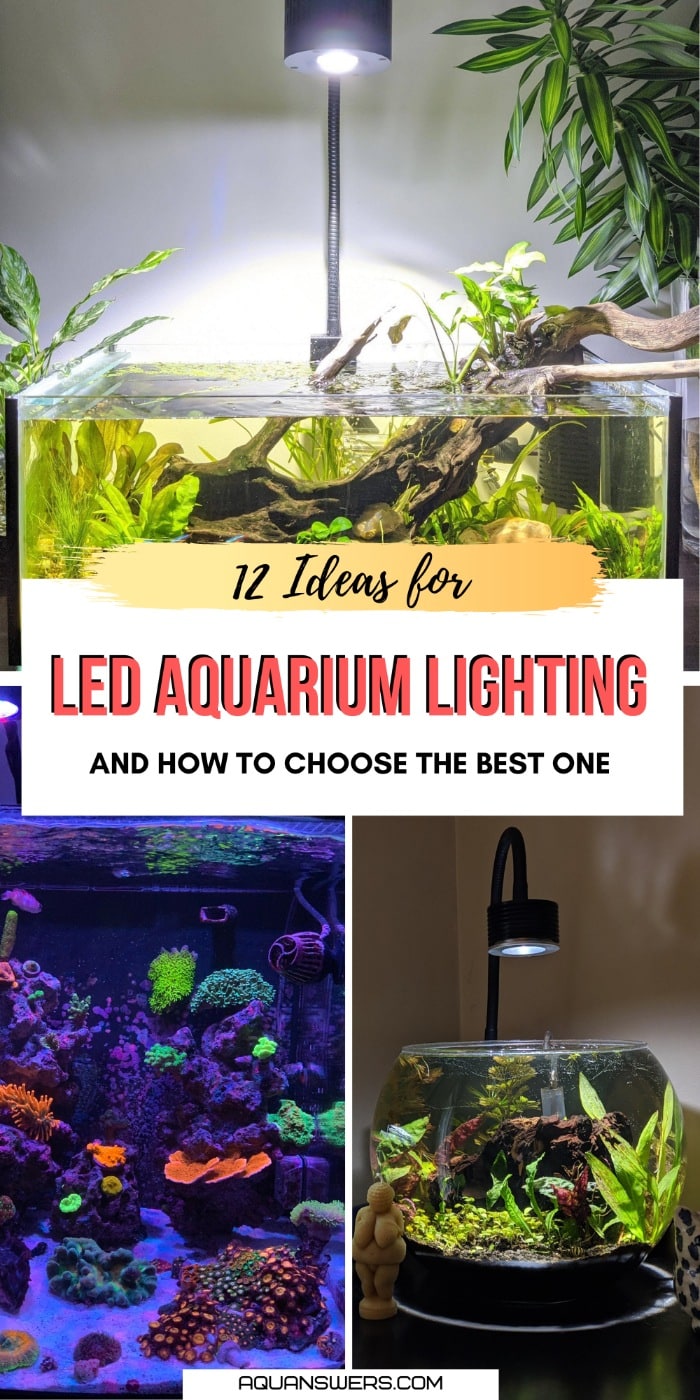
Do me a favor and leave me a short comment with your thoughts. Thanks.

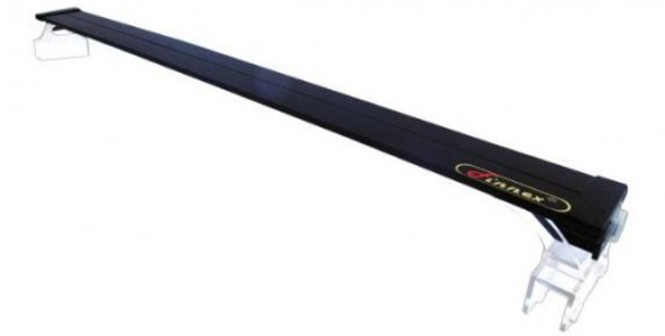
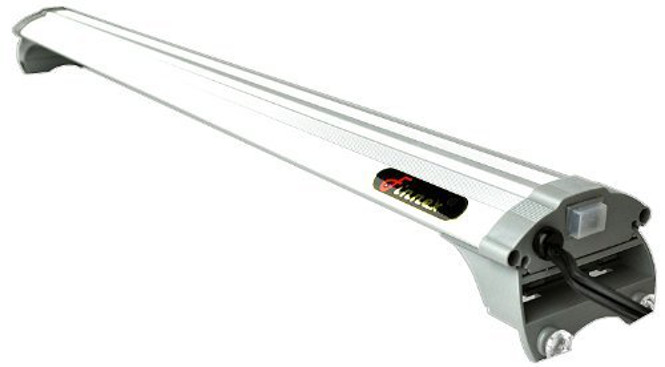
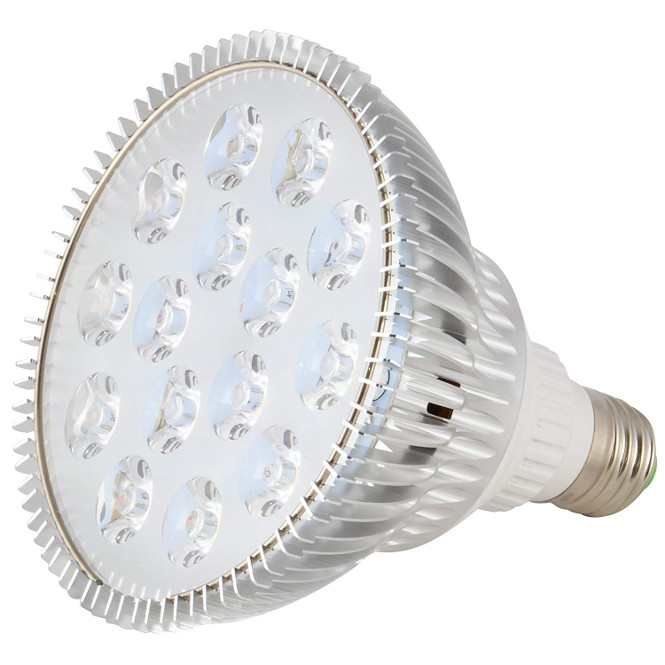
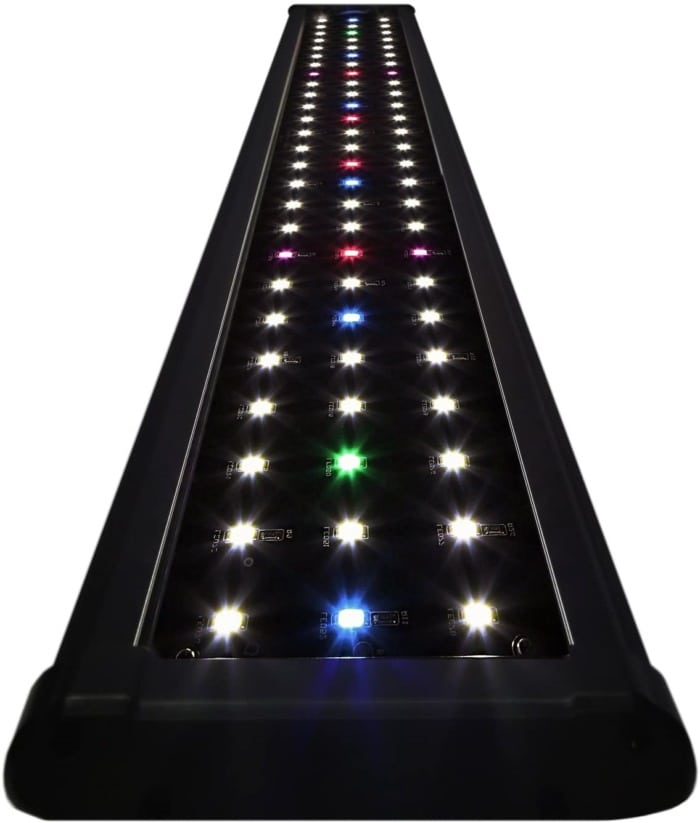
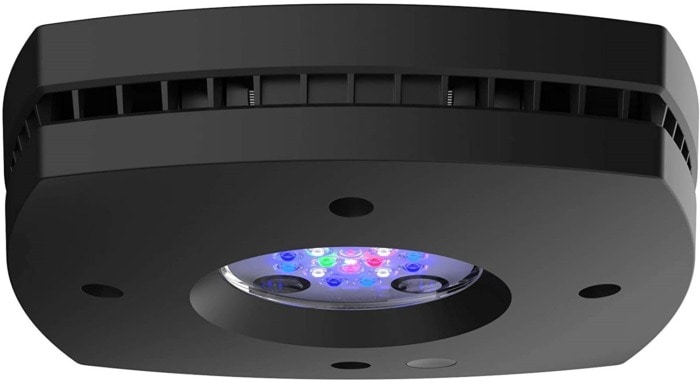
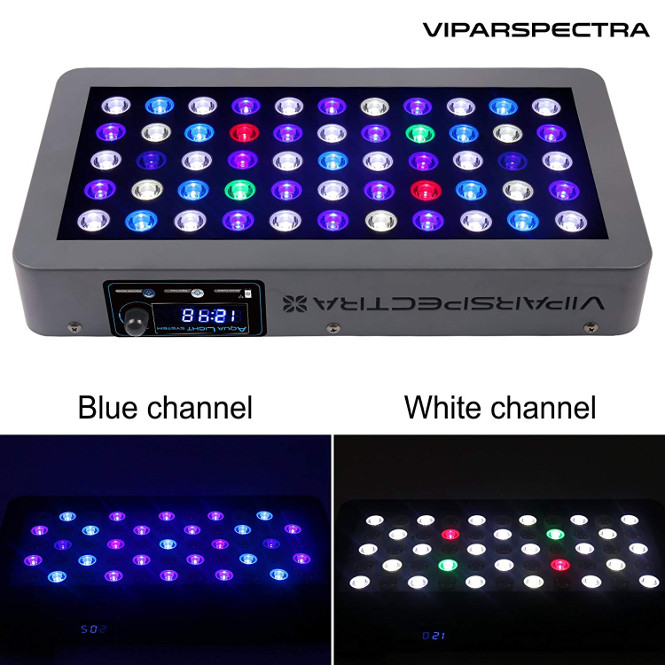
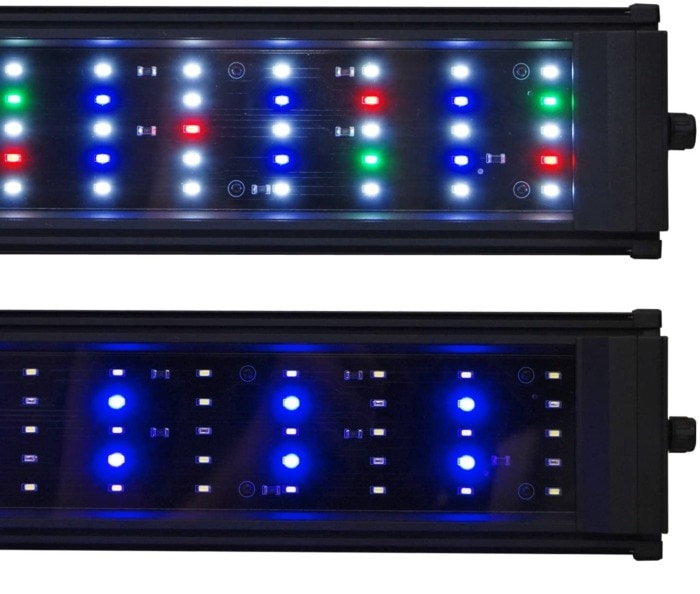
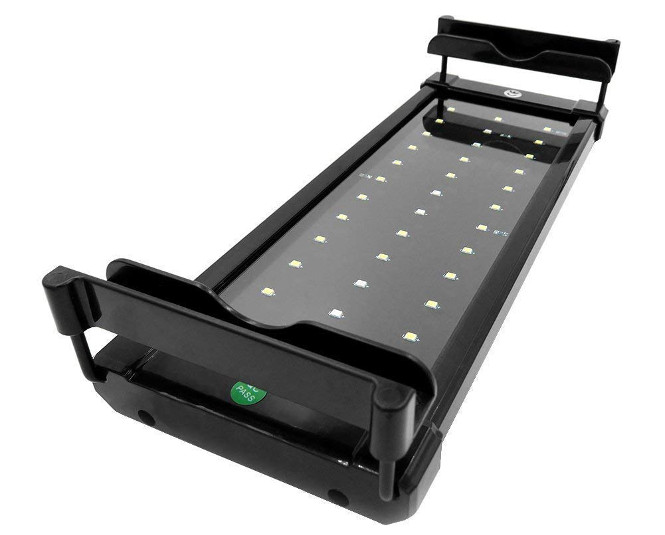
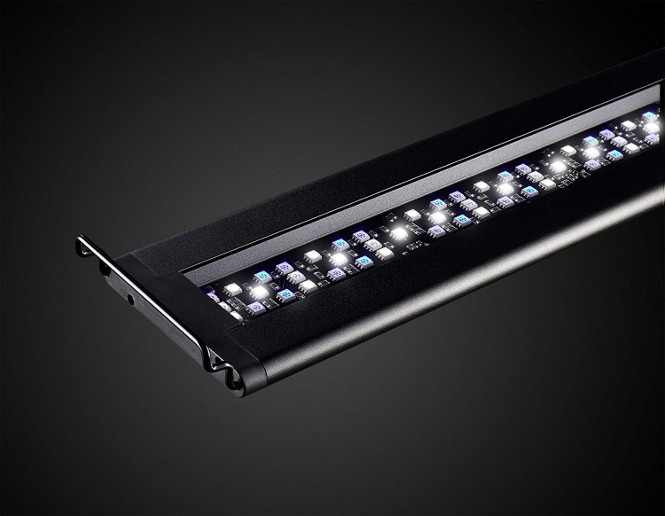
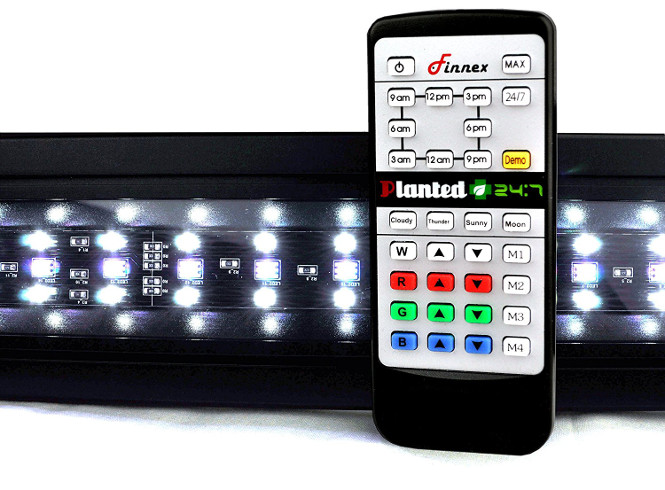
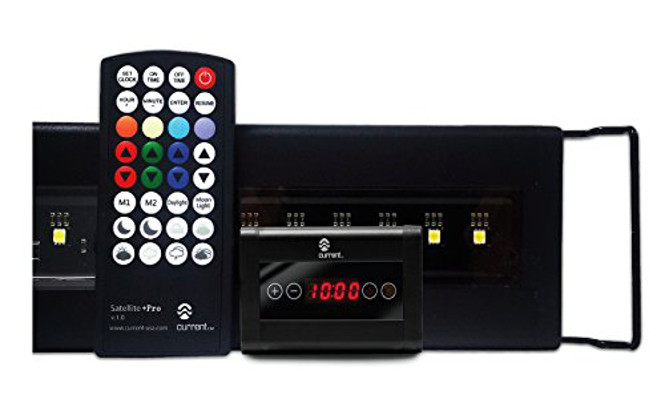
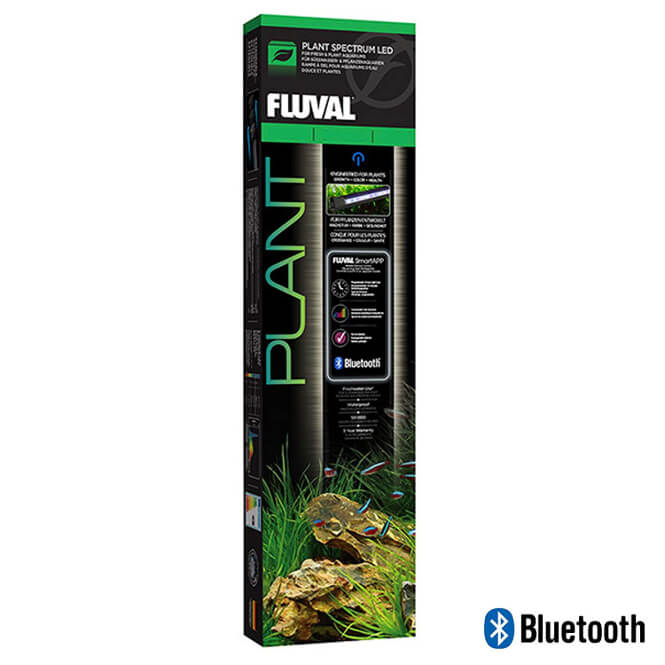
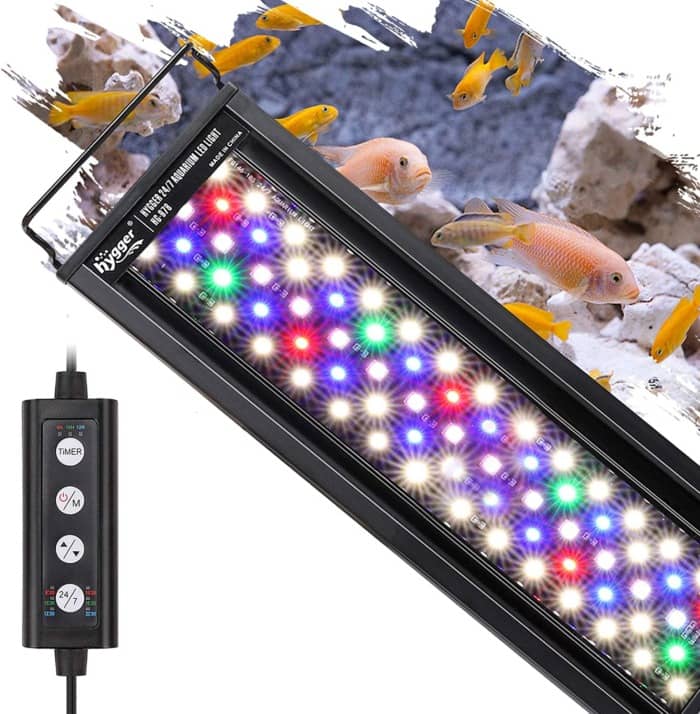
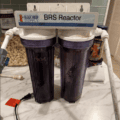
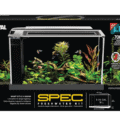
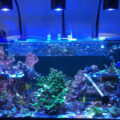
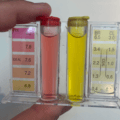
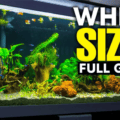

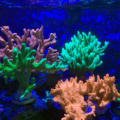
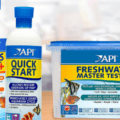
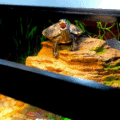
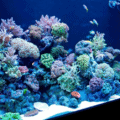
46 thoughts on “Best LED Aquarium Lighting Units for Your Gallon Tank Capacity”